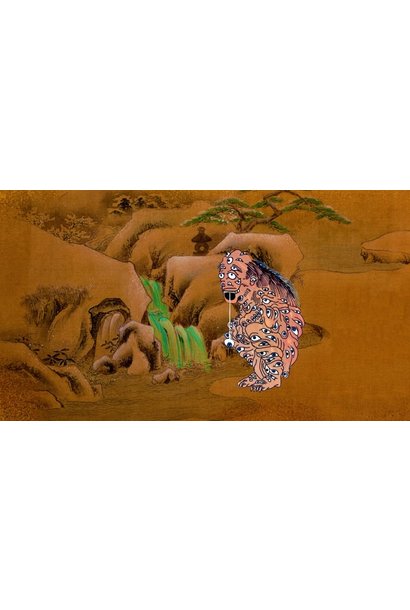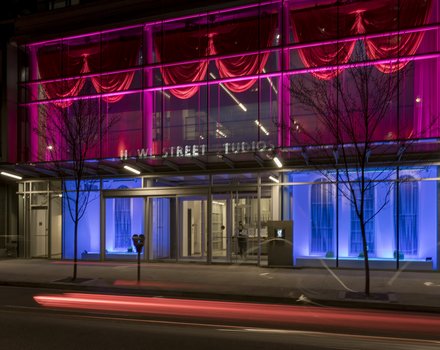

Marina Roy & Abbas Akhavan Fire/Fire
C$ 0.00 Excl. tax
- File number: EXHI1026
...
Fire/Fire calls out like a warning, of obvious danger, perhaps too late. The title is derived from the Great Fire of Meireki, which destroyed more than half of the Japanese capital city of Edo, leading to the redistribution of power and the establishment of the Edo period that gave birth to the tradition of Ukiyo-e prints in Japan. It also refers to the Great Vancouver Fire of 1886, which razed most of the newly incorporated city, and more recently the building fires that expelled artists from their studios, paving the way for new real estate and condo development. Fires are testament to our inability to control nature.
It is often said that the gulf that separates humans from animals is language, yet the distinction can be troubled. John Berger wrote:
What distinguishes man from animals was the human capacity for symbolic thought, the capacity which was inseparable from the development of language in which words were not mere signals, but signifiers of something other than themselves. Yet the first symbols were animals. What distinguished men from animals was born of their relationship with them (Berger, John, Why Look at Animals, About Looking, 1980, p. 9).
The works created by Abbas Akhavan and Marina Roy examines language in respect to this relationship. A continuation of Fire/Fire, concurrently installed at Centre A, the exhibition at Malaspina Printmakers is a condensation of works examining human and animal relationships.
Throughout the legends depicted in Ukiyo-e prints the dynamics between humans and animals were often represented. Prior to the Westernization and industrialization of Japan, the nation’s folklore and legends told of beings that often shifted between human, animal and ghostly forms. Often these stories were rooted in the animism that pervaded the indigenous Shinto belief system. Japanese printmaker Yoshitoshi sought to preserve the tradition and culture through the practice of Ukiyo-e and representing stories of the pre-industrialized times in a land inhabited by a myriad of creatures and animated spirits. Moon of Kintoko’s Mountain, from the suite of prints One Hundred Aspects of the Moon by Yoshitoshi Tsukioka depicts the story of Oniwaka. Known as the “demon child” or the “golden boy”, Oniwaka grew up in the mountains living with the animals and developing superhuman strength before eventually becoming a famous warrior. In this particular print he is seen observing a monkey and a hare fighting, while they wrestle he appears at peace, though immersed in watching.
Akhavan’s woodblock prints are a distillation of the material essence of the Ukiyo-e. The prints, uncut and printed as a monochrome, move closer toward contemporary forms of minimalist art. However it is in their titles that they become activated and transformed, the purity contaminated. The titles, such as Bucking Bronco and Donkey Punch, come from the names of sex acts, most of them brutally rough or derogatory to one of the partners. The pieces seem to question simultaneously the strange use of language, and how we might regard levels of humanity in considering these acts. However without knowledge of the title’s hidden meaning the prints can maintain a double life as elegant pastel prints with strangely incongruous animal based titles. Meanwhile the process of printing lends a sense of both intimacy and aggression as the plates are pressed into and imprint upon the surface of the paper.
Roy’s video, The Legend of Saint Julian, is a reading of the artist’s translations of Flaubert’s text of the same name. As the story is read the screen remains black, but each time the narrator pauses for a breath the screen flashes with closeup video of dead animals from a zoology collection. The story tells of the life of Julian who develops a perverse obsession with killing every animal he encounters. The relation between the text and images become more gruesome as the story unfolds. A continual sense of loss develops between the brief flashes of the images, their absence hangs heavy in our minds between breaths.
These works speak to the rupture between humans and animals from the process of industrialization. In the years since the making of Yoshitoshi’s print the gulf has widened and threatens the diversity of life on the planet as extinction rates increase rapidly. Through these works we are invited to question how we might reconsider our symbolic thoughts in regards to our relationship with animals.
Curated by Andrea Pinheiro
This exhibition was made possible through the support of the Arts Partners in Creative Development, Ontario Arts Council, Canada Council for the Arts, BC Arts Council, Province of British Columbia, and the City of Vancouver.
Cross-disciplinary in scope, Marina Roy’s art practice investigates the intersection between materials, language, history, and ideology. Her work addresses the desire for a post-humanist perspective, counter to the dictates of humanistic hubris and biopolitical control. Materials and objects themselves have multiple potential agency, and art can act as a bridge between culture and nature, ethics and drive.
Roy has exhibited locally, nationally and internationally. In 2001 she published sign after the x (Artspeak/Arsenal Pulp), a book which revolves around the letter X and its multiple meanings. In 2010 she was recipient of the VIVA art award, British Columbia’s largest visual art award. She is associate professor of visual art in the Department of Art History, Visual Art, and Theory, at the University of British Columbia.
Abbas Akhavan was born in Tehran, and currently lives and works in Toronto. His practice ranges from site-specific ephemeral installations to drawing, video and performance. For the past five years, the domestic sphere has been an ongoing area of research in Akhavan’s work. Earlier works explore the relationship between the house and the nation state and how the trauma of systemic violence enacted upon civilians can be inherited and re-enacted within the family lineage – the home as a forked space between hospitality and hostility. More recent work has shifted focus onto spaces just outside the home – the garden, the backyard, and other domesticated landscapes.
Akhavan’s work has been exhibited in spaces including Vancouver Art Gallery, Darling Foundry, and Power Plant (Canada), KW Institute for Contemporary Art (Germany), Kunsten Museum of Modern Art (Denmark), Performa 11 (USA), Belvedere Museum (Austria) and The Delfina Foundation (England). Akhavan was the recipient of Kunstpreise Berlin (2012). Akhavan is represented by The Third Line.
Recently viewed
-
 Favoriten
Add to cart
Favoriten
Add to cart
Marina Roy & Abbas Akhavan Fire/Fire
C$ 0.00 Excl. tax


